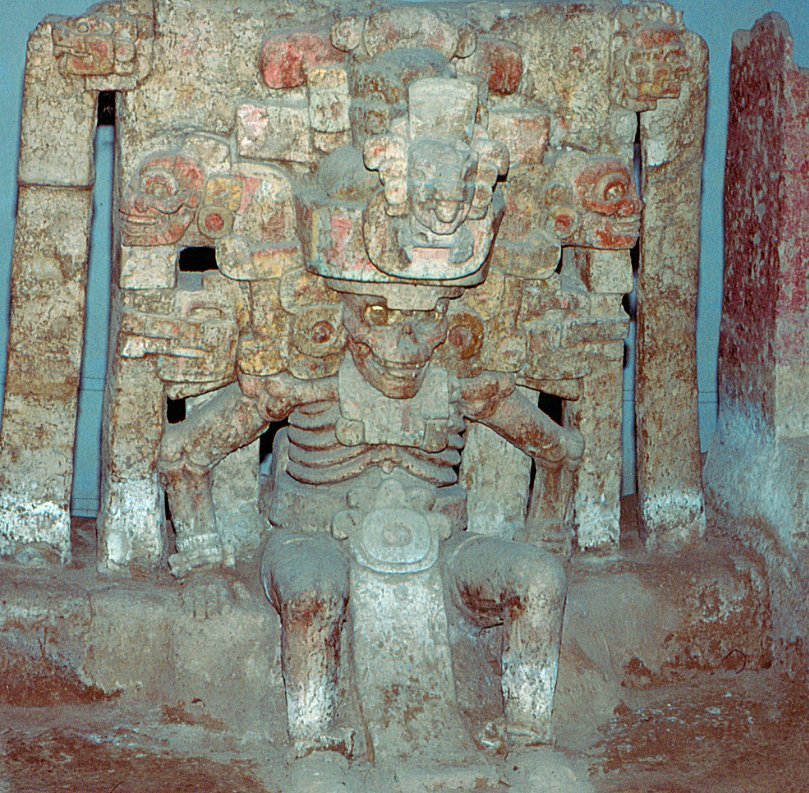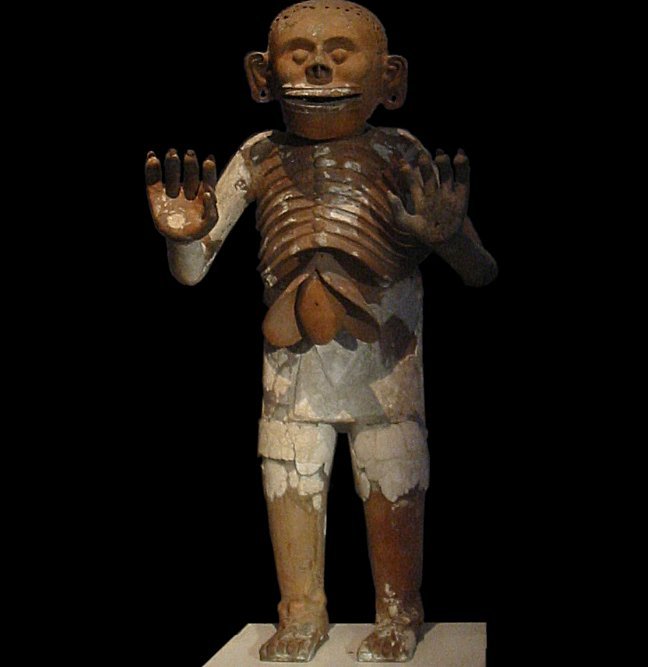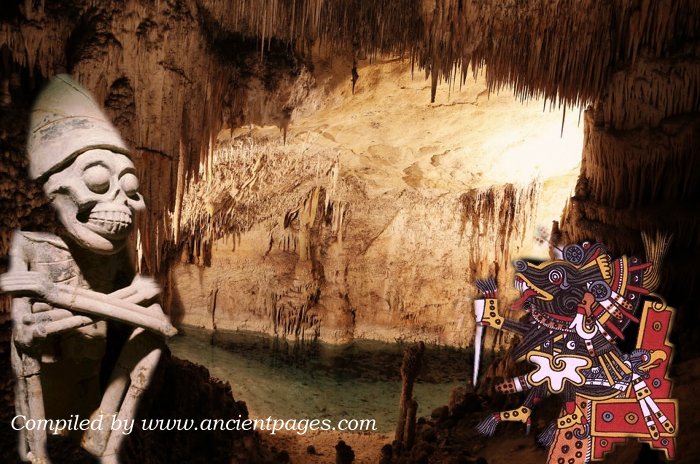Mictlan – Underworld Realm Of The Dead In Ancient Aztec Beliefs
A. Sutherland - AncientPages.com - In Aztec and Maya mythology, the Underworld (Xibalba for the Maya and Mictlan for the Aztecs) played an important role. In the beliefs of these ancient people, death was closely incorporated into the world of the living, and death is evident in almost every aspect of Aztec and Maya thought, culture, and tradition.
Statue of Mictlantecuhtli, El Zapotal, Veracruz, Mexique. Image via Wikipedia
The Aztec and Mayan mythologies describe what will happen to the spirit once the individual has died.
It was believed that the souls of ordinary people went to an underworld called Mictlan – the place of the dead. Each soul wandered through the layers of Mictlan until it reached the deepest level.
The Maya's Xibalba and the Aztec's Mictlan (or even the Norse place of the dead (Niflheim), symbolized a realm where violations of religious and moral rules were punished. These punishments included not only physical torture (often involving fire, walking upside down, eating excrement, and drinking urine) but also the agony of being cut off from God.
Statue of Mictlantecuhtli, lord of the Mictlan. Image credit: Musée du Templo Mayor, Mexico.
It is interesting how the Aztecs imagined the Mictlan.
Vision Of Mictlan
The Underworld of Aztec mythology, Mictlan (or Chiconauhmictlán), has been described as a "vast place, very dark place that has no windows light." It also has other names like Ximoayan, a place "where are the fleshless," or Atlecalocan, "without exit to the street."
According to the ancient beliefs of the Aztec people, at the time of death, the individual had to make the trip back to the maternal womb, to its place of origin. That's why the deceased was placed in a fetal position, and their soul had to undertake the trip to Mictlan and cross nine hazards and dangers, as it happened inside the womb during the nine lost menstrual periods and the nine-month-long pregnancy.
For the Aztecs, the world of the afterlife was arranged in 13 layers of the heavens and nine of the Underworld. The fate of the deceased was determined based on how this person died. A belief that, in some ways, reminds of the Norse Valhalla.
Most of those who died violent deaths entered the heavenly realm; one of the layers in heaven was reserved for sacrificial victims, those who perished in combat, and for women who died in childbirth (who were recognized as warriors who fell to the battling infant).
Another place was reserved for those who committed suicide. According to Aztec beliefs, yet another heavenly realm was reserved for those who drowned; it became an offer of deadly decease sent by the rain gods and even those struck by lightning.
Many Hard Challenges To Face
Most people who died of ordinary death entered Mictlan, the Underworld, and there, they had to face many trials like their Maya counterparts did when they entered Xibalba.
The journey from the first level to the ninth was four years long and arduous. The dead had to face several dangerous challenges, such as crossing a path full of snakes and challenging an area with strong winds that were so sharp they sliced at the skin like a knife, and the only protection from these terrible winds was a blanket buried with the dead.
Another test was to go through two mountains that collide with each other whenever a spirit passed between, in an attempt to crush the soul. Another challenge was to cross a river of blood with fearsome jaguars, and it was terrifying to encounter frightening demons that ate human hearts.
The Xolotl (a dog associated with this deity) accompanied the deceased. Like the Greek Charon and the Egyptian God Anubis, Xolotl also led the souls on their journey to the Underworld.
After four years of passing these roads, the deceased had ended the wandering and could finally cross a large, plentiful river mounted on his dog.
The exhausting journey was over. The deceased reached the Mictlan and could approach Mictlantecutli (Lord of death) and his wife, Mictecacihuatl (Lady of death), who ruled the Land of the Dead.
Mictlantecuhtli was a terrifying figure. In his "Encyclopedia of the Rulers Evil Spirits and Geographies of the Dead," Ernest L. Abel writes:
"Mictlantecuhtli had an insatiable hunger for human flesh and blood. He was a blood-splattered, partially de-fleshed skeleton with a menacing grin who wore a headdress with owl feathers, a necklace of human eyeballs, a human bone for an earplug, and had claws for hands in which he carried a knife or axe to remove the hearts of those he claimed. He was accompanied by animals such as the bat, centipede, owl, scorpion, and spider…"
Certain animals played an essential role in the Aztec beliefs. Bats symbolize death since they live inside the caves and only come out at night. Also, lizards and snakes were associated with death, and they accompanied the dead on the way to Mictlan.
The dog also connected with death, but this animal beneficially helped the deceased through many dangers in the Underworld.
Written by – A. Sutherland AncientPages.com Senior Staff Writer
Updated on February 17, 2024
Copyright © AncientPages.com All rights reserved. This material may not be published, broadcast, rewritten or redistributed in whole or part without the express written permission of AncientPages.com
Expand for referencesReferences:
Austin A. L. The Human Body and Ideology: Concepts of the Ancient Nahuas
Hayes B. Aztec Mythology
More From Ancient Pages
-
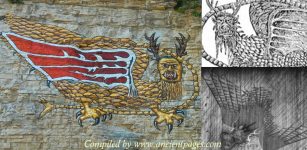 Mysterious Piasa Bird – Native American Dragon That Existed Thousands Of Moons Before The Pale Face Came
Featured Stories | Jan 1, 2018
Mysterious Piasa Bird – Native American Dragon That Existed Thousands Of Moons Before The Pale Face Came
Featured Stories | Jan 1, 2018 -
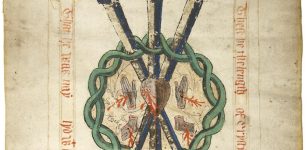 Previously Unknown Manuscript Reveals New Insight Into Medieval Christian Beliefs In England
Archaeology | Oct 26, 2021
Previously Unknown Manuscript Reveals New Insight Into Medieval Christian Beliefs In England
Archaeology | Oct 26, 2021 -
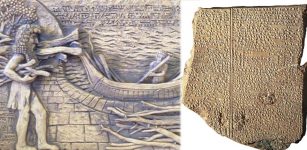 Utnapishtim And The Babylonian Flood Story
Featured Stories | Jan 28, 2016
Utnapishtim And The Babylonian Flood Story
Featured Stories | Jan 28, 2016 -
 India’s Tradition Of Advanced Metallurgy, Craftsmen And Blacksmiths Is Longer Than Thought
Ancient Technology | Mar 19, 2019
India’s Tradition Of Advanced Metallurgy, Craftsmen And Blacksmiths Is Longer Than Thought
Ancient Technology | Mar 19, 2019 -
 Ötzi The Iceman’s Stomach Bacteria And Complex History Of European Settlements
Archaeology | Jan 8, 2016
Ötzi The Iceman’s Stomach Bacteria And Complex History Of European Settlements
Archaeology | Jan 8, 2016 -
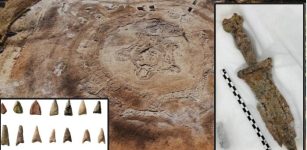 Impressive Copper Age 5,000-Year-Old Fortification With Concentric Walls, Bastions, A Shallow Grave With A Man Face Down And A Dagger – Unearthed
Archaeology | Feb 17, 2025
Impressive Copper Age 5,000-Year-Old Fortification With Concentric Walls, Bastions, A Shallow Grave With A Man Face Down And A Dagger – Unearthed
Archaeology | Feb 17, 2025 -
 Controversial Ancient History Of Harappa And Mohenjo Daro – Advanced Indus Valley Civilization Pre-Dates Egypt’s Pharaohs And Mesopotamia
Civilizations | Apr 15, 2017
Controversial Ancient History Of Harappa And Mohenjo Daro – Advanced Indus Valley Civilization Pre-Dates Egypt’s Pharaohs And Mesopotamia
Civilizations | Apr 15, 2017 -
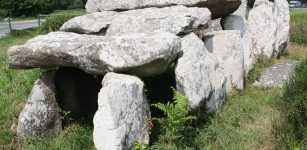 Mysterious Megalithic Stones Of Carnac, France – An Unsolved Neolithic Enigma
Civilizations | Oct 12, 2018
Mysterious Megalithic Stones Of Carnac, France – An Unsolved Neolithic Enigma
Civilizations | Oct 12, 2018 -
 Michael Scott – Fascinating Wizard Who Tutored The Holy Roman Emperor Frederick II
Featured Stories | Mar 7, 2025
Michael Scott – Fascinating Wizard Who Tutored The Holy Roman Emperor Frederick II
Featured Stories | Mar 7, 2025 -
 Mysterious Magical Healing Gift Of The Whisperers – Meet The Enigmatic Szeptunka
Featured Stories | Feb 10, 2025
Mysterious Magical Healing Gift Of The Whisperers – Meet The Enigmatic Szeptunka
Featured Stories | Feb 10, 2025 -
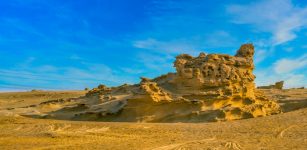 Abu Dhabi Fossil Dunes May Have Inspired The Ancient Great Flood Story – Professor Says
Archaeology | Jul 10, 2022
Abu Dhabi Fossil Dunes May Have Inspired The Ancient Great Flood Story – Professor Says
Archaeology | Jul 10, 2022 -
 Evidence Of Ritualistic Gatherings 35,000 Years Ago Found In The Manot Cave In Galilee, Israel
Archaeology | Dec 12, 2024
Evidence Of Ritualistic Gatherings 35,000 Years Ago Found In The Manot Cave In Galilee, Israel
Archaeology | Dec 12, 2024 -
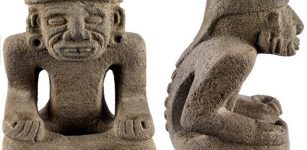 Huehueteotl: Old Aztec God Of Fire, Time And Aging – Ceremony Of The New Fire
Aztec Mythology | Jan 31, 2019
Huehueteotl: Old Aztec God Of Fire, Time And Aging – Ceremony Of The New Fire
Aztec Mythology | Jan 31, 2019 -
 Coca-Cola Was Invented As A Cure For Headache And Hangover In The 1880s
Ancient History Facts | Oct 23, 2017
Coca-Cola Was Invented As A Cure For Headache And Hangover In The 1880s
Ancient History Facts | Oct 23, 2017 -
 10 Mysterious Ancient Manuscripts With Hidden Secrets
Featured Stories | May 27, 2016
10 Mysterious Ancient Manuscripts With Hidden Secrets
Featured Stories | May 27, 2016 -
 Bacho Kiro Cave: Early Homo Sapiens Groups In Europe Faced Subarctic Climates
Archaeology | Sep 24, 2021
Bacho Kiro Cave: Early Homo Sapiens Groups In Europe Faced Subarctic Climates
Archaeology | Sep 24, 2021 -
 Hairy Snail Discovered In 99-Million-Year-Old Amber
Archaeology | Oct 29, 2022
Hairy Snail Discovered In 99-Million-Year-Old Amber
Archaeology | Oct 29, 2022 -
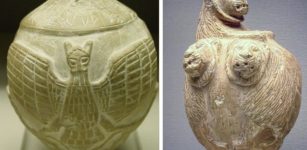 ‘Stone Club Head Of Mesilim’ Probably The Most Powerful Sumerian Ruler At That Time
Artifacts | Oct 12, 2017
‘Stone Club Head Of Mesilim’ Probably The Most Powerful Sumerian Ruler At That Time
Artifacts | Oct 12, 2017 -
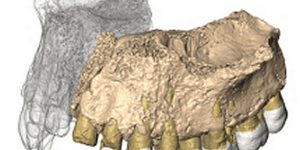 Earliest Modern Human Fossil Outside Africa Unearthed At Misliya Cave, Israel
Archaeology | Jan 27, 2018
Earliest Modern Human Fossil Outside Africa Unearthed At Misliya Cave, Israel
Archaeology | Jan 27, 2018 -
 The Great Pyramid And Ancient Egyptian Knowledge Shed Light On Biblical Mysteries – Resurrection Of The Flesh – Part 1
Ancient Mysteries | Nov 25, 2019
The Great Pyramid And Ancient Egyptian Knowledge Shed Light On Biblical Mysteries – Resurrection Of The Flesh – Part 1
Ancient Mysteries | Nov 25, 2019

